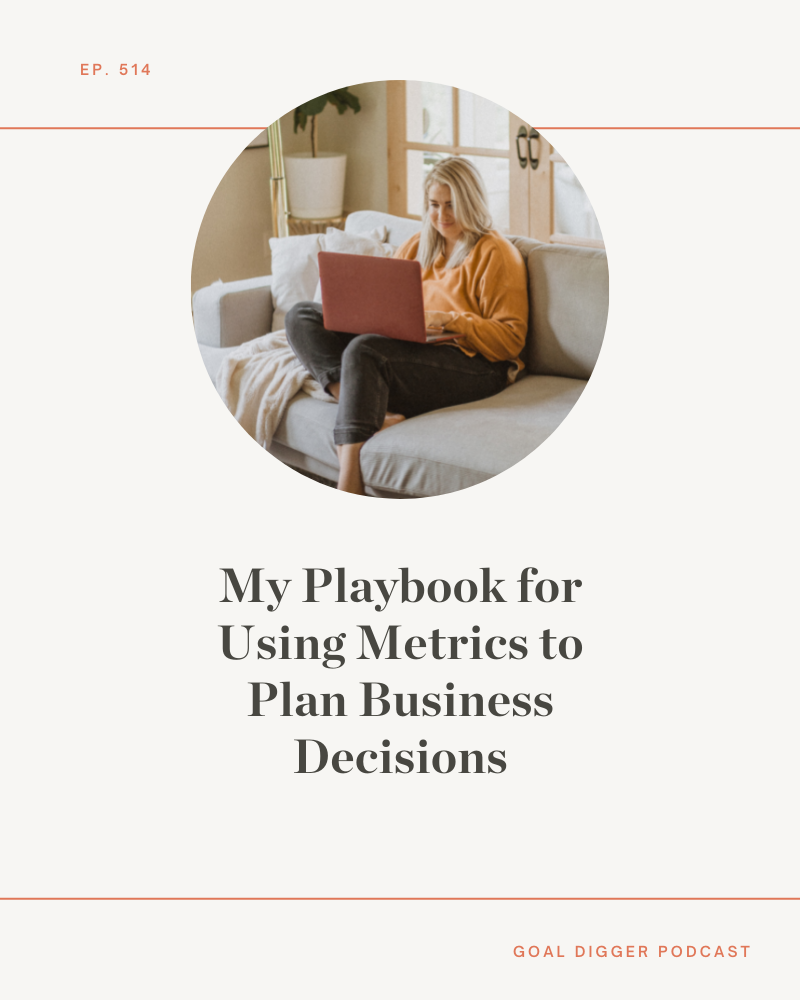
Apple Podcasts | Spotify | Stitcher
Knowing your numbers is something a lot of business owners avoid. What is it about numbers that’s so intimidating? Even as a total self-proclaimed analytics nerd who’s obsessed with strategy and tracking and all things metric-oriented… there IS something vulnerable about stripping away the vanity metrics or the social media facade to only look at the black and white numbers and what they have to say about the health of your business.
I’ll be walking you through the 6 must-know metrics for you as a business owner. Are you ready to dive on in and talk numbers with me? Here we go!
Numbers Don’t Lie
As we all know, numbers don’t lie. If certain things aren’t doing so hot, the numbers will let you know. One of the reasons I love numbers is that they represent an equation void of emotion.
I wasn’t formally tracking anything really until I had my business coach Dean on the podcast and he challenged me to know my “key performance indicators” or KPIs and get both a scorecard and an integrator. Turns out… he was so right – as he usually is – because even though I had a pretty good general sense of what was going on in the business and how we were doing from a birds eye view, I didn’t have the more granular look at specific pieces of the business and how they’re doing on a weekly, monthly and annual basis.
Two other incredible resources on this topic are the books Traction by Gino Wickman and Rocket Fuel by Gino Wickman and Mark C. Winters, and if you’re just getting into the idea of tracking metrics and operating as the visionary of your business, I’d recommend reading or listening to one or both to get a fuller picture of what you can shift to easily incorporate a way to track your key performance indicators and spend less time wondering or worrying about whether your efforts are truly converting and worth your while.
In an article from AllBusiness.com, it gives three main reasons why you need to be tracking your numbers:
- It reduces stress because you know exactly where you’re at, how things are performing, and what needs improvement at a glance every single week.
- It improves team performance, since everyone’s actions can be tied to a result and a number that lets them keep a pulse on what they should be focusing their efforts on. Side note, even if you don’t have a team, knowing your numbers is an important practice so that you can see where your attention is most needed rather than trying to prioritize everything at once.
- And finally, it alerts you of problems early on so that you can create solutions and course correct before it reaches a red alert level.
So is tracking your numbers intimidating? It sure can be, so let’s walk through six of the basic key metrics to start with to keep a pulse on in your business, so that you can get a system in place that allows you to build a practice of knowing your numbers, noticing trends and forecasts, and anticipating where you’ll end up before the year is over.
Profit and loss statements
If you AREN’T tracking this metric and the only time you know how you’re doing is when you’re frantically pulling numbers for tax season, I’d recommend implementing a system to keep track of profits and losses ASAP. This is where having an accountant or bookkeeper can be wildly transformative. They’ll keep track of your P&L for you and provide reports to share trends, upswings, forecasts, and reviews that help you understand where to focus more of your attention and where to maybe back off a little, whether it’s with expenses or with offers or products that aren’t converting as well as others.
Do what you can to keep a pulse on these numbers every single month of the year, not just when April 15th is around the corner.
Revenue
Real quick, let’s talk about the foundational difference between profit and revenue. Revenue is the total amount of income generated from your sales, while profit is the amount of income remaining AFTER accounting for all of your expenses and operating costs. So you’ll want to take a look at what’s driving the biggest amount of money into your business each and every month.
We don’t just want to track overall revenue, but individual revenue streams for every service, product, or offer that’s available to your clients and customers. Track each item’s revenue – or what it’s bringing into the business – to see which offers are performing and where your strongest revenue is coming from – as well as what efforts are driving it.
A lot of times, understanding what is moving the needle the most in terms of offers, promotions, and sales can help you to really harness the necessary knowledge and power to scale and focus on the RIGHT things.
Oftentimes I see it end up looking a whole lot like the Pareto Principle, where 80% of the results come from 20% of your efforts. In other words, the majority of your revenue likely comes from a small amount of your offers. You might THINK all these offers are doing pretty darn well, but when you dig into the individual revenue numbers month by month, you’ll likely find that one or two offers are providing 80% or more of your results.
How can you double down there and make those offers even more awesome and fruitful? It starts with knowing what they are and what you do differently to promote and deliver those high-performing offers.
Website and blog traffic
First things first, blogging is NOT dead, in fact long form content marketing is doing really well. Traffic is one of those things that might not feel super important because it’s not directly tied to a dollar amount – BUT it is valuable because the more people landing on your website and consuming your content, the greater odds you have of capturing them as a part of your audience and the better chance they have of buying from you at that time or in the future.
Make sure you’re tracking your traffic at least once a month – although we actually track this on a weekly basis to see what content or sharing strategy gives us the best boost from week to week. You can hook Google Analytics up to your website to view these traffic numbers, or your blog or website backend might even have data for you to use – or if you don’t have a website or blog, track traffic on your podcast or YouTube channel by seeing how many streams or views you’re getting.
You can also track your traffic on your Facebook and Instagram pages if you have a business account for each of those platforms. The bottom line is, more eyes mean more opportunities to make conversions and acquire new customers. So knowing how your traffic is trending – up or down or staying pretty neutral – this can tell you which content is most valued by your audience and then you can make more like it to bolster that traffic even more!
Cost per acquisition
Truth be told, finding your cost per acquisition isn’t necessarily an easy number when starting out, but it becomes easier to find once you begin investing in paid ads because most platforms will actually straight-up tell you your CPA. But it IS something to be thinking about regardless of whether you have ads, and it can help you make sure your margins are large enough for you to be driving a profit.
A quick way to get a handle on it is by looking at how many dollars it costs you to acquire a new customer or make a sale, so that you can adequately price your offers so that they make sense. If you DON’T pay for ads at this point in time, look at your expenses for one product for a month vs. how much that one product brings in. That’s your cost per acquisition!
Detailed monthly expenses
It’s so funny because I hear a lot of solopreneurs or service-based business owners say they don’t really have any expenses because it’s just them on their own working in their business for clients one to one – they’re not creating any products or paying a team or shipping anything.
But then I ask about their computer or their Wifi that they use for work, and any dedicated office space, and whether or not they pay for an email or accounting platform or other softwares, or if they’ve ever paid a contractor for copywriting or branding… and suddenly it becomes apparent that they do indeed have some expenses!
Most businesses have some monthly expenses, whether they’re super obvious or not, and it’s important to be aware of the breakdown of how your money is being put to use. The more in touch you are with your expenses, the more likely you are to make sure that any money out is tied to tangible, measurable results that you can keep track of as a business owner.
You can also see if there are any business costs that have become unnecessary and then cut those out to save money by streamlining your expenses.
Conversion rates
This can look a little different for everyone, though, whether it’s the conversion rate from your social media efforts to the purchaser, or the amount of people who purchase your product from your webinar or presentation, or what percentage of your email subscribers click and purchase a product.
Being aware of your conversion rates and which channels drive the best rates can help you understand where your efforts are best spent and also help you to thoughtfully forecast where to spend your efforts in the future.
Forbes said it like this: “Your marketing efforts won’t mean anything if nobody is converting. Everything you do must have that idea in mind.” Essentially, wherever you’re spending time to promote your business, you should be able to track whether people then choose to purchase from you or move to another stage of keeping in touch with your business, like joining your email list or signing up for your Facebook group. Knowing what marketing efforts convert the highest will allow you to continue creating similar campaigns that drive similar results!
The Big Picture
It doesn’t have to be super complicated or time consuming either. We literally keep our scorecard in a Google spreadsheet that the whole team has access to, and we add the new numbers we track every Monday from the previous week’s performance.
Simply choose which numbers you’re going to keep track of, create an easy place to store them like a spreadsheet, and then choose a consistent time to update them, whether that’s the same day every week or the first day of every month. You might even want to put a reminder in your calendar as you get the hang of your new metric tracking routine!
Over time, you’ll begin to notice trends, rhythms, and indicators for how you can be spending more of your time, efforts, resources, and energy in the business to allow your numbers to thrive – which then allows your business to thrive, too.
Knowing your numbers might feel intimidating at first, but I promise it’s one of the best practices you can get into the habit of maintaining for the sake of a healthy business, a thoughtful approach to what you focus on, and a more balanced way to scale and grow your business to the next level – without the overwhelm.
Thank you to our Goal Digger Sponsors
Learn more about how a HubSpot CRM platform can help connect the dots of your business
Post a job on LinkedIn for free — Terms and conditions apply.




